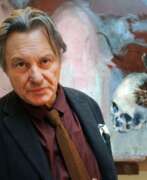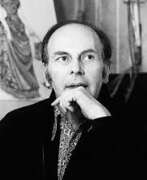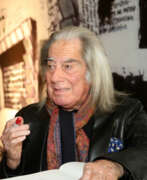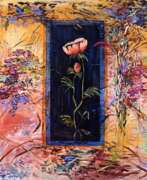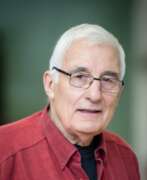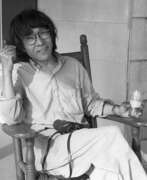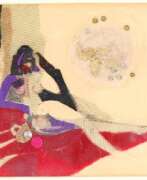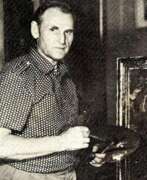Decorators 21st century


André Beaurepaire was a French artist and scenic designer.
Beaurepaire studied at the École des Beaux-Arts in Tours, and later in Paris at the École Nationale Supérieure des Arts Décoratifs. He worked as a painter and a graphic artist, and also designed sets and costumes for theater productions and films.
Beaurepaire was particularly well-known for his work as a scenographer, and collaborated with many major French directors and choreographers, including Jean-Louis Barrault, Roger Planchon, and Maurice Béjart. He designed sets for a number of classic works of theater, including Shakespeare's "Hamlet" and "Macbeth," Molière's "The Misanthrope," and Jean Anouilh's "Antigone."
In addition to his work as a scenographer, Beaurepaire continued to paint throughout his career, and his works were exhibited in galleries and museums in France and abroad. His paintings are characterized by their vibrant colors and dynamic compositions, often featuring abstract or geometric shapes.


Michel Boyer was one of the last great interior designers who remained true to the principles of modernity.
Boyer collaborated with Dior, Lanvin, Balmain and designed interiors for hotels, embassies and numerous corporate headquarters. His private clients have included Elie de Rothschild, Liliane Betancourt and Karim Aga Khan.


Hans-Ulrich Buchwald was a German painter, graphic artist, ceramist, stage designer and mask maker. His oeuvre comprises about 10,000 drawings, woodcuts and linocuts, paintings, ceramics, wooden sculptures and masks. It is characterised by a variety of artistic forms of expression. Buchwald felt committed to classical modernism, which he only became acquainted with after the war. He was inspired by George Grosz, Pablo Picasso, Edvard Munch, August Macke, Franz Marc, Oskar Schlemmer, Fernand Léger, but sought his own style in various fields.


Ivan Ivanovich Chorny (Russian: Иван Иванович Чёрный) was a Soviet, Ukrainian and Russian artist of the second half of the twentieth and early twenty-first centuries. He was known for his monumental and decorative works in the style of socialist realism.
Ivan Chorny reoriented his style in the late 1990s, inventing a new technique and moving away from figurativeness in favor of abstract painting. His enigmatic compositions became an expressive expression of inner feelings enriched with colors and lines.


Christo & Jeanne-Claude are an art duo, the married couple Christo Vladimirov Javacheff (1935-2020) and Jeanne-Claude Denat de Guillebon (1935-2009), an iconic pair of innovative land-art artists. They are known for their large-scale installations: they are packing great historical landmarks, working with huge spaces and monumental natural objects. Their projects are distinguished by what they call "Americanism" in Europe - that is, something grandiose and large-scale. Christo and Jeanne-Claude's work is in many major public collections.


Aleсos Fassianos (Greek: Αλέκος Φασιανός), also Alexandre Fassianos, was a Greek painter, writer and poet. He is internationally known for his figurative paintings that depict the contemporary world in a mythological way.
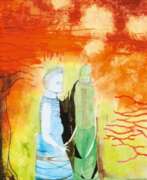

Lothar Hempel is a German media artist living and working in Berlin.
Lothar studied at the Academy of Fine Arts Düsseldorf and works in a wide range of media, combining the abstract and figurative in dramatic stage sets. Drawing from a variety of styles - Dadaism, Constructivism, the Bauhaus school - Hempel creates works in the fields of sculpture, drawing and painting, video, performance and installation. He utilizes visual metaphors, including images or found objects.
Lothar Hempel has been exhibiting regularly since 1991.
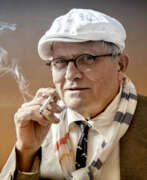

David Hockney, a British artist, has been a prominent figure in the art world for over six decades, renowned for his contributions to painting, drawing, printmaking, photography, and video art. His exploration of these mediums has made significant impacts on the Pop Art movement and beyond, making him one of the most influential artists of the 20th and 21st centuries. Hockney's work is celebrated for its vibrant color palette, emotional depth, and innovative use of technology in art.
One of Hockney's most distinctive features is his ability to blend traditional techniques with modern technology, notably in his iPad drawings and photographic collages. This fusion not only showcases his skillful adaptation to contemporary mediums but also highlights his ongoing quest to explore the nature of seeing and representation in art. Hockney's landscapes and portraits, characterized by their bright colors and meticulous detail, invite viewers to see the world through his unique perspective.
Significant works by Hockney, such as "A Bigger Splash" and "Portrait of an Artist (Pool with Two Figures)," are housed in major museums and galleries worldwide, attesting to his global influence and appeal. These pieces, among others, demonstrate Hockney's mastery over space, light, and narrative, securing his position as a pivotal figure in modern and contemporary art.
For collectors and experts in art and antiques, Hockney's oeuvre presents a fascinating study in the evolution of visual arts. His work not only offers insight into the artist's personal vision but also reflects broader cultural and technological shifts in society. As interest in Hockney's art continues to grow, keeping abreast of new sales and auction events becomes increasingly valuable.
To stay informed about the latest David Hockney sales and auction events, sign up for our updates. This subscription ensures that you receive timely notifications about new product sales and auction events related to David Hockney, offering unique opportunities for collectors and enthusiasts alike.


Jörg Immendorff was a German painter and sculptor, stage designer and decorator, and a member of the New Wild movement.
Immendorff painted in cycles that often lasted for years and were political in nature. His series of sixteen large paintings, Café Deutschland (1977-1984), is well known. In these colorful paintings, numerous disco lovers symbolize the conflict between East and West Germany.
Immendorff prepared several stage productions and designed sets for the operas Elektra and The Rider's Voyage. 25 of Immendorf's paintings were selected in 2006 for the illustrated Bible.


Margrethe Alexandrine Thorhildur Ingrid (Danish: Margrethe Alexandrine Þórhildur Ingrid) is Her Majesty Queen Margrethe II of Denmark.
Since 1970 she has been active in several artistic expressions: painting, church textiles, watercolours, prints, book illustrations, decoupage, set design and embroidery. Many of these artistic works have been shown at exhibitions in Denmark and abroad.
Margrethe II's works are represented in art museums such as the Statens Museum for Kunst (Danish National Gallery), Aarhus Art Museum, ARoS and Køge Art Gallery Sketch Collection (sketches for church textiles).


Titina Maselli is an Italian pop-art artist and stage designer.
Born into a creative family, she has lived and worked in Rome, Paris and New York.
Maselli's works futuristically depict the modern dynamic life of big cities with their skyscrapers, nighttime traffic lights and neon signs. In Titina Maselli's cities athletes compete, cyclists race, boxers fight furiously - the artist was able to portray all this best in pop-art style.
Titina Maselli has also worked as a stage designer, creating sets and costumes for famous theatrical productions.


Carlo Nangeroni is an American and Italian abstractionist and stage designer.
Nangeroni has lived and worked in the United States and Italy. As a scenic artist he painted sets for many theatrical and opera productions. In painting Nangeroni experimented with abstract expressionism.


Lev Voldemarovich Nusberg, also Nussberg (Russian: Лев Вольдемарович Нусберг) is a Russian artist, architect and designer. He is considered one of the most important representatives of Russian Kinetic Art.
Nussberg studied architecture at the Moscow Institute of Civil Engineering and later at the Moscow University of Industrial Design. In the 1960s, he began to focus on kinetic artworks, which he described as "machines" that used movement and light to create a dynamic visual experience.
His works have been exhibited in many major museums and galleries around the world, including the Guggenheim Museum in New York, the Centre Georges Pompidou in Paris and the Tretyakov Gallery in Moscow.
Nusberg's work is known for its sophisticated technique and sense of humour. Many of his kinetic machines are interactive, encouraging viewers to interact with them and influence their movements and patterns.
In addition to his work as an artist, Nusberg also has a successful career as an architect and designer. He has been involved in the design of many important buildings in Moscow, including the Hotel Ukraina and the GUM shopping centre.
Overall, Nusberg has made a significant contribution to the Russian art and design scene and is now considered one of the country's most important artists.


Joseph Gallus Rittenberg is an Austrian photographer, stage designer and painter. Rittenberg grew up in Gallneukirchen and has lived in Munich since 1977. His photographs have been shown at exhibitions in Berlin, Paris, Vienna and New York, among others, and have also been published in magazines (e.g. Süddeutsche, Die Zeit and Der Spiegel) since the 1980s. His work focuses on portraits. His photographs of the writers Thomas Bernhard and Werner Schwab, Friederike Mayröcker and Ernst Jandl became well known.


Mike Rose, born Klaus Viktor Gottfried Rose, was a German painter, set designer, and writer, renowned for his diverse contributions to art and literature. Rose's journey into the artistic realm began in Niedersachsen, Germany, where he was born on November 22, 1932. His career spanned several decades, and he left an indelible mark in multiple artistic areas.
His artistic evolution is fascinating. During the early part of his career, Rose was significantly influenced by the Parisian group “Lettriste,” leading him to develop the "Zeichen im Zeichen" (the sign in the sign) series, employing strong motifs with black and red paint on rough canvas. His multidimensional paintings, created between 1985 and 1995, showcased an innovative approach to space and perception, integrating space with letters and signs. From 1995 until 2006, Rose's work pivoted towards expressing emotions, focusing on the human condition and its relationship with the environment.
Rose's talents were not confined to painting alone. He made notable contributions to the world of theater as a set designer, crafting stage sets for numerous plays including works by Eugène Ionesco, Max Frisch, and Henrik Ibsen. His multidisciplinary approach also extended to literature, with several publications to his name.
Today, Mike Rose's works find their place in various collections, including those of the Bamberger Bank, Citibank, Sparkasse Bamberg, and the cities of Bamberg, Castrop-Rauxel, Munich, and Nuremberg. His artistic legacy continues to inspire and influence contemporary art and literature.
For collectors and experts in art and antiques, Mike Rose's works represent a blend of cultural depth and innovative artistry. His paintings, stage designs, and literary works reflect a profound understanding of human emotions and perceptions, making them invaluable to the world of art.
To stay updated on new sales and auction events related to Mike Rose's works, sign up for our updates. This subscription is a gateway to exploring the rich and diverse legacy of this remarkable German painter and poet.


Tahir Salahov (Russian: Таир Теймурович Салахов) was an esteemed Soviet and Azerbaijani painter and draughtsman, celebrated for his pivotal role in the art world. Born in Baku, Azerbaijan, Salahov's journey into the arts commenced at the Azimzade Art College before advancing to the Surikov Moscow Art Institute. Early in his career, his work, particularly "The Shift is Over," garnered significant attention and acclaim, marking his prominence in the art scene.
Salahov's artistry is renowned for its embodiment of the "severe style," a movement within Soviet art in the 1960s that sought to provide a realistic, publicist view in contrast to the polished, idealized portrayal prevalent during the Stalin era. His masterpieces, notably portraits and scenes depicting the life of Baku oil workers, are lauded for their powerful expression and lack of idealization. Salahov's work underwent an evolution over the years, with his later pieces showcasing more peaceful, lyrical contemplations with evident Eastern influences, as seen in "Portrait of Grandson Dan." This transition is marked by smoother lines and a more sophisticated palette, highlighting his versatility and depth as an artist.
Salahov's contributions extended beyond his paintings; he was a key figure in several art academies and organizations worldwide, including the Artists' Union of the USSR and the Russian Academy of Arts. His achievements have been recognized with numerous awards, such as the People's Artist of the USSR and the Order "For Merit to the Fatherland." Salahov's legacy is cemented not only through his artworks but also through his significant impact on the cultural and artistic heritage of Azerbaijan and the broader Soviet and post-Soviet space.
For collectors and art enthusiasts, Salahov's work represents a crucial junction in the narrative of 20th-century art, bridging the gap between realism and the thematic, stylistic diversities of Soviet and Azerbaijani art. His paintings and drawings, many of which reside in prestigious museums, continue to inspire and captivate audiences worldwide.
If you're keen on exploring the life and works of Tahir Salahov further, consider signing up for updates. Subscribers will be alerted to new product sales and auction events related to Salahov's art, ensuring you stay informed about opportunities to engage with the legacy of this monumental artist.


Vladimir Ivanovich Stelmashonok (Russian: Владимир Иванович Стельмашонок) was a Belarusian and Soviet artist of the second half of the twentieth and early twenty-first centuries. He is known as a painter, graphic artist and teacher.
Vladimir Stelmashonok worked in different genres and techniques. In easel painting he created mainly portraits - mainly of figures of history and culture of Belarus. In monumental and decorative art, the creative heritage of the artist includes a number of monumental works in Minsk, Ukraine and East Germany, including stained glass windows and mosaics for metro stations.


Stefan Szczesny is a German expressionist painter, draftsman and ceramic sculptor, co-founder of the Neue Wilde movement.
Szczesny's vivid paintings and figurative works are inspired by the spirit of the Caribbean and the colorful, sensual Mediterranean way of life. One of his famous works is Living Planet.
The talented and versatile artist has also worked on the entire island of Mainau: he has created numerous ceramics of various shapes and sizes, large glass steles and many other objects, including a bridge and a painted NT airship, turning the island into a real work of art.


Valentino Vago was an Italian painter known for his large-scale murals.
He studied painting at the Brera Academy of Fine Arts and participated in numerous exhibitions.
Since 1979 he has devoted himself to mural painting, painting public and private spaces as well as churches in Italy and abroad. One of Valentino Vago's most impressive works is the Church of Our Lady of the Holy Rosary in Doha, Qatar, where the artist painted 12,000 square meters.


Theofiel Agnes van de Kerckhove was a Belgian painter, graphic artist, set designer and scenographer.
He studied painting at the Antwerp Academy, where he also took classes with sculptors Dekkers, Claessens and Dupont, and joined the Rupelgouw artists' association in Boom in 1936. Van de Kerckhove worked as a stage designer at the opera in Lille, and lived for a time in Germany. Here he worked with Albert Servaes, whom he had met while at the academy. In the 1950s, Van de Kerckhove was a curator at the Rocoxhuis and one of the set designers for Belgian television.


Andrei Vladimirovich Vasnetsov (Russian: Андре́й Влади́мирович Васнецов) was a prominent Russian painter, muralist, and a veteran of World War II. He was a key figure in the development of the "Severe Style" in Soviet art, which emerged as a significant movement during the mid-20th century. Vasnetsov's artistic heritage includes a diverse range of works including portraits, landscapes, still lifes, and monumental art such as frescoes and mosaics for public buildings across the USSR.
Born into a family of artists, Andrei was deeply influenced by his grandfather, Victor Vasnetsov, a celebrated master of historical painting. This familial legacy enriched his approach to art, combining traditional themes with a modernist vigor that defined his contributions to Russian art. Vasnetsov's education at the Moscow Institute of Applied Art and the Leningrad Higher School of Art and Industry further honed his skills, particularly in monumental painting.
His works are part of several prestigious collections, including the State Tretyakov Gallery and the Russian Museum, underscoring his significance in the Russian art scene. His commitment to art extended beyond creation; he was an influential mentor and educator, inspiring future generations of artists.
For art collectors and enthusiasts wishing to explore or acquire works by Andrei Vasnetsov, staying informed about upcoming auctions and private sales can be essential. Sign up to receive updates on new artwork sales and auction events featuring Vasnetsov's works, ensuring you never miss an opportunity to own a piece of this influential artist's legacy.


Claude Viseux is a French painter and sculptor. Claude Viseux's works can be found in many public spaces in France and in museums around the world. He also participated in the design and creation of ballet sets and costumes.


Irma Weiland was a German artist who worked mainly in painting and drawing.
Throughout her career, Weiland explored various artistic styles, including expressionism, surrealism and abstraction. She was particularly known for her expressive works, in which she often used bold colours and geometric shapes.
Irma Weiland's paintings are included in many private and public collections.


Björn Wiinblad was a Danish artist and designer. He was best known for his work in ceramics, but he also worked in a variety of other media, including glass, textiles, and graphics.
Wiinblad studied at the Royal Danish Academy of Fine Arts in Copenhagen before beginning his career as a freelance artist and designer. In the 1950s, he gained international recognition for his work in ceramics, which was characterized by his use of bright colors, whimsical patterns, and intricate details.
Wiinblad's ceramic pieces were often functional, such as plates, vases, and bowls, but he also created large-scale ceramic murals and sculptures. His work was heavily influenced by fairy tales, mythology, and the arts and crafts movement.
In addition to his work in ceramics, Wiinblad also designed textiles, glassware, and furniture, and he was an accomplished graphic artist. He created illustrations for books and magazines, as well as posters, advertisements, and even a set of postage stamps for the Danish postal service.
Wiinblad's work has been exhibited in museums and galleries around the world, and he has been the recipient of numerous awards and honors for his contributions to the arts. His designs continue to be popular today, and his ceramics and other works can be found in the collections of many museums and private collectors.






















